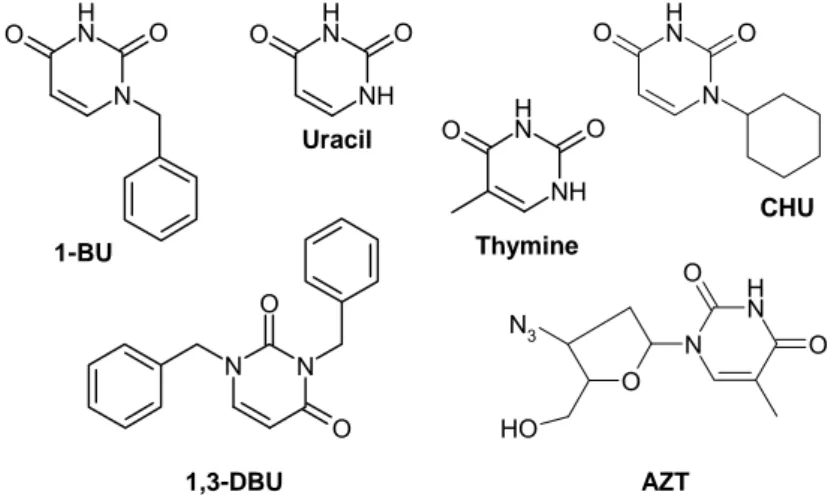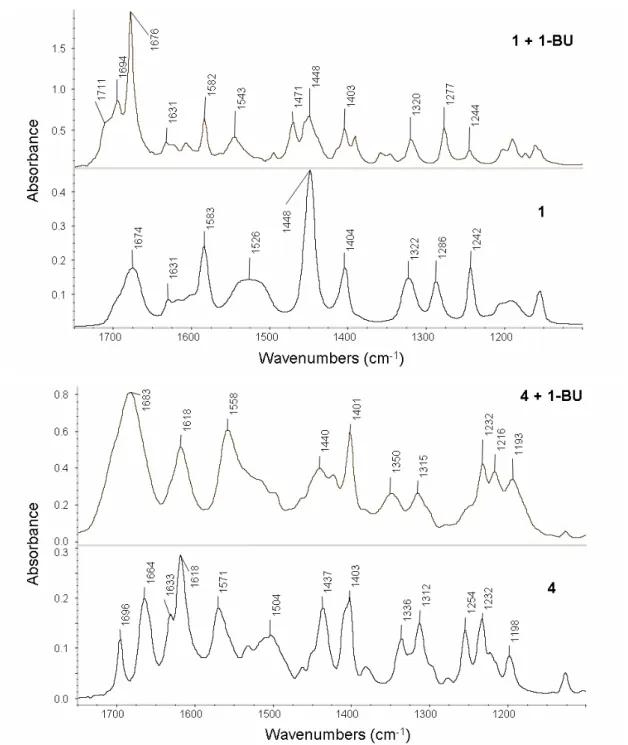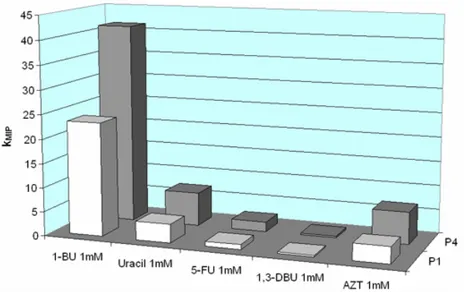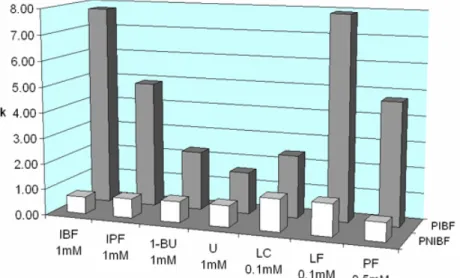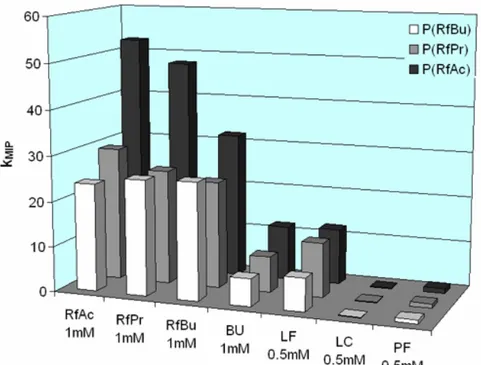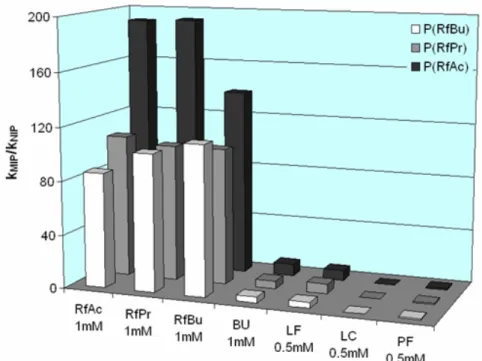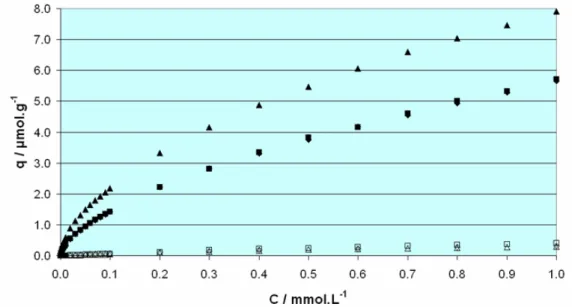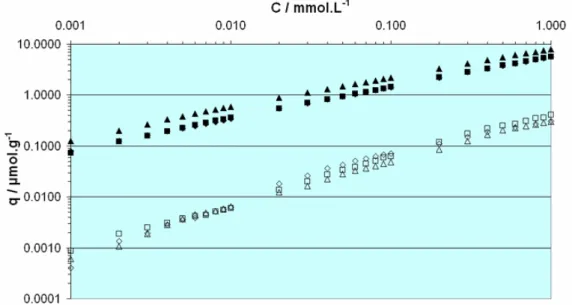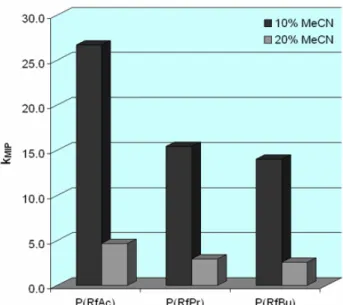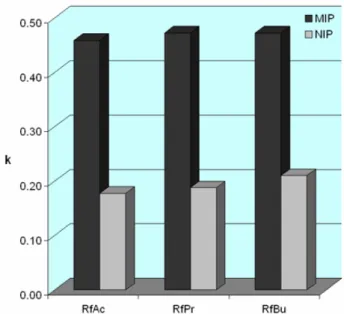WATER COMPATIBLE MOLECULARLY IMPRINTED POLYMERS FOR THE RECOGNITION OF
BIOLOGICALLY ACTIVE COMPOUNDS IN AQUEOUS MEDIA
Dissertation
Dipl-Chem. Panagiotis Manesiotis
Universität Dortmund, Institut für Umweltforschung Oktober 2005
WATER COMPATIBLE MOLECULARLY IMPRINTED POLYMERS FOR THE RECOGNITION OF
BIOLOGICALLY ACTIVE COMPOUNDS IN AQUEOUS MEDIA
Dem Fachbereich Chemie der Universität Dortmund zur Erlangung des akademischen Grades eines
Doktor der Naturwissenschaften (Dr. rer. nat.)
vorgelegte Dissertation
von:
Dipl-Chem. Panagiotis Manesiotis
geboren am 28.03.1979 in Korinthos, Griechenland
Betreuer : Priv. Doz. Dr Börje Sellergren Koreferrent: Univ.-Prof. Dr Christof M. Niemeyer
Universität Dortmund, Institut für Umweltforschung Oktober 2005
Acknowledgements
Throughout my work that led to this doctoral thesis I had the opportunity and pleasure to meet, collaborate and interact with several persons, whose contribution made life, the universe and… everything, a better place to be.
These persons I would like to thank in this short foreword…
PD Dr Börje Sellergren, my supervisor, for the opportunity to join his group and for the creative guidance throughout this doctoral work.
Prof. Dr Michael Spiteller, head of the INFU, where the second part of this work was carried out, and all the members of the “INFUland” for the nice atmosphere and friendly environment. Especially Ulrich Schoppe, the
“secretary of state” at the INFU, the greatest fan of OYZO and Greek food, whose theory “there are no problems; there are only solutions” has definitely saved me a few years of life… Servus!
Prof. Georgios Theodoridis, from Aristotle University of Thessaloniki, Greece, for introducing me to the field of molecular imprinting and for being a great friend and supporter in good and bad times. Mrs. Vasiliki Mpika and Mrs.
Maria Mprouma, the two fantastic librarians at the Library of the Department of Chemistry, A.U.Th., Greece, for advice and assistance regarding bibliography and literature resources.
Dr Andrew J. Hall, for an early kick-start in this work, for guidance through the paths of polymer and supramolecular chemistry and for all the great times in and out of working premises.
Dr Marco Emgenbroich and Anika Wolf-Emgenbroich; the first for being a great guy and my partner in the organisation and setup of group events (e.g.
GSS v.1 and v.2) and for all the fun setting-up the new labs, and both of them for introducing me to the real German spirit and culture.
Dr Maria-Magdalena Titirici, with whom we started work for our PhDs on the same day, for the great cooking hours followed by great parties, and for the Balkan understanding throughout these years.
All members of the Sellergren group, present and former, featuring: Carla Aureliano, Cristiana Borrelli, Ravindra Deshmukh (the most fluent Indian in the Greek language), Dr Yasumasa Kanekiyo, Dr Francesca Lanza-Sellergren
(Karl and Maria-Anna as well), Issam Lazraq, Dr Eric Schillinger, Dr Jeroen Verhage (otherwise known as “Μήτσος”), Filipe Vilela, Bettina Hofmann and Kim Schwarzkopf (the “apprentices”).
Prof. Dr Klaus K. Unger and the ”Ungerverse“ from Johannes Gutenberg Universität Mainz, where everything started, for the great welcome and quick incorporation in the group. Especially, Jakob T. Mossing, who made the first steps in the riboflavin/uracil project and spent a lot of time in bringing me up to speed before leaving, Dr Vassilis Stathopoulos, who spent only a small period of time in Mainz, but made a lot of difference in the general understanding of things and the way days go by (e.g. φραπέ και τάβλι), Dr Sandra Pati, for being a great friend and for a great guided tour of Rome, and Dr Bernd Mathiasch for introducing me to NMR spectroscopy in practice and for all the help he offered with NMR titrations.
Dr Anthony Rees, Dr Ecevit Yilmaz, Brian Boyd and Christian Svensson from MIP Technologies, Sweden, for a greatly educating week in Lund and for the flawless collaboration in the development of the riboflavin imprinted polymer.
Prof. Gianluca Ciardelli and the Biomedical Research group in Pisa, for a great week in Italy, in scientific and recreational matters. Especially, Davide Silvestri, my main collaborator there, for the introduction to membrane science, and Alfonsina Rechichi, whose stay in Dortmund for two weeks forced for me to finally understand the grafting techniques.
Dr Paul Hughes and Dr Eric Brouwer from Heineken Technical Services, Zoeterwoude, the Netherlands, for the perfect cooperation and the donation of beer samples (usually in large volumes) for mainly research purposes.
Cheers!
Last, but certainly not least, Despina Economopoulou, my beloved girlfriend, whose support throughout my doctoral work was invaluable, my family, farther Georgios, mother Vasiliki, sister Katerina, and all my friends for the moral support and tolerance all these years… Σας ευχαριστώ πολύ!
Financial support by the European Union through the MICA and AquaMIP projects and from Heineken Technical Services is gratefully acknowledged.
Table of Contents
1 ZUSAMMENSFASSUNG ... 1
2 SUMMARY ... 4
3 INTRODUCTION ... 7
3.1 MOLECULAR IMPRINTING... 9
3.1.1 …explained in a few words...9
3.1.2 What are the potential targets?...10
3.1.3 MIPs vs. Host-Guest chemistry ...10
3.1.4 Thesaurus of terms used in Molecular Imprinting...11
3.1.5 Approaches to Molecular Imprinting ...12
3.1.6 Morphologies of Molecularly Imprinted Polymers...15
3.1.7 Applications of Molecularly Imprinted Polymers ...18
3.1.8 Conclusions and perspective of MIPs ...20
3.2 THE TEMPLATES SELECTED FOR THIS STUDY... 21
3.2.1 Uracil and its biological importance ...21
3.2.2 Riboflavin and its natural receptor ...23
3.2.3 Glutamic acid and related compounds ...25
4 RESULTS AND DISCUSSION... 28
4.1 SCOPE OF THE WORK... 28
4.2 IMPRINTING OF URACIL DERIVATIVES... 30
4.2.1 1st generation of monomers for the recognition of uracils ...30
4.2.2 1st generation of MIPs against 1-benzyluracil...32
4.2.3 Chromatographic evaluation of the 1st generation MIPs ...33
4.2.4 2nd generation of monomers for the recognition of uracils...36
4.2.5 2nd generation of MIPs against 1-benzyluracil ...49
4.2.6 Mode of monomer incorporation...50
4.2.7 Chromatographic evaluation of the 2nd generation MIPs...53
4.2.8 Batch rebinding experiments ...55
4.2.9 Fluorescence monitored batch rebinding ...57
4.2.10 Attempts to prevent dimerisation...60
4.2.11 Conclusions ...61
4.3 WATER COMPATIBLE IMPRINTED POLYMERS FOR THE RECOGNITION OF RIBOFLAVIN... 63
4.3.1 Solubility of riboflavin ...63
4.3.2 Phenyl flavin and alkyl flavins ...63
4.3.3 IBF imprinted polymers...66
4.3.4 Riboflavin tetra esters as template analogues...69
4.3.5 Polymerisation at lower temperatures ...82
4.3.6 Incorporation of hydrophilic co-monomers ...84
4.3.7 Use of alternative cross-linkers I – TRIM...86
4.3.8 Use of alternative cross-linkers II – PETRA ...89
4.3.9 Use of alternative cross-linkers III – PEDMA...95
4.3.10 Incorporation of π – stacking co-monomers...97
4.3.11 Post-hydrolysis of the imprinted polymers ...101
4.3.12 Extraction of riboflavin from real samples ...107
4.3.13 Isothermal Titration Calorimetry ...115
4.3.14 Conclusions ...117
4.4 RECOGNITION OF CARBOXYLATE ANIONS... 119
4.4.1 Monomer design ...119
4.4.2 The mono-urea monomers ...119
4.4.3 Imprinting of N-Z-L-Glutamic acid...125
4.4.4 The bis-urea monomer ...128
4.4.5 Conclusions ...130
4.5 RECOGNITION OF CARBOXYLIC ACIDS... 131
5 CONCLUSIONS AND OUTLOOK ... 134
6 EXPERIMENTAL PART... 138
6.1 SYNTHESIS OF FUNCTIONAL MONOMERS... 138
6.1.1 Synthesis of 9-(3/4-vinylbenzyl)adenine...138
6.1.2 Synthesis of 9-(3/4-vinylbenzyl)-2,6-diaminopurine...139
6.1.3 Synthesis of 2,6-bis(acrylamido)pyridine...139
6.1.4 Synthesis of 2,6-bis(propylamido)pyridine...140
6.1.5 Synthesis of 2-propylamido-6-aminopyridine ...141
6.1.6 Synthesis of 2-acrylamido-6-(propylamido)pyridine ...141
6.1.7 Synthesis of 6-(piperidin-1-yl)pyrimidine-2,4-diamine ...142
6.1.8 Synthesis of 2,4-bis(acrylamido)-6-(piperidino)pyrimidine ...143
6.1.9 Synthesis of 2,4-bis(propylamido)-6-(piperidino)pyrimidine ...144
6.1.10 Synthesis of 2,4-diamino-6-ethoxypyrimidine ...145
6.1.11 Synthesis of 2,4-bis(acrylamido)-6-ethoxypyrimidine...145
6.2 SYNTHESIS OF TEMPLATES... 147
6.2.1 Synthesis of 1-benzyluracil ...147
6.2.2 Synthesis of 10-isobutylbenzo[g]pteridine-2,4(3H,10H)-dione (IBF) ...148
6.2.3 Synthesis of 10-isopentyl-benzo[g]pteridine-2,4(3H,10H)-dione (IPF)...152
6.2.4 Synthesis of riboflavin tetraacetate (RfAc) ...153
6.2.5 Synthesis of riboflavin tetrapropionate (RfPr)...154
6.2.6 Synthesis of N-3-methyl riboflavin tetraacetate ...155
6.3 SPECTROSCOPIC TECHNIQUES... 156
6.3.1 NMR spectroscopy ...156
6.3.2 UV-Visible titrations ...160
6.3.3 Fluorescence titrations...162
6.3.4 Attenuated Total Reflectance Infrared Spectroscopy (ATR-IR) ...163
6.4 PREPARATION OF IMPRINTED POLYMERS... 164
6.4.1 Monomer and initiator purification...164
6.4.2 Polymer preparation ...164
6.4.3 Post-treatment of the imprinted polymers...165
6.5 CHROMATOGRAPHIC EVALUATION OF IMPRINTED POLYMERS... 167
6.5.1 Packing an imprinted material into an HPLC column ...167
6.5.2 Derivation of retention and imprinting factors ...168
6.5.3 Frontal analysis...170
6.5.4 Binding isotherm models ...172
6.6 EQUILIBRIUM REBINDING EXPERIMENTS... 173
6.6.1 Batch rebinding...174
6.6.2 Fluorescence-monitored batch rebinding ...174
6.7 ONLINE MIP–SOLID PHASE EXTRACTION... 175
6.7.1 Extraction of riboflavin from aqueous solutions ...176
6.7.2 Extraction of riboflavin from a water-soluble vitamins mixture ...176
6.8 OFFLINE EXTRACTIONS... 177
6.8.1 Extraction of riboflavin from beer samples ...178
6.8.2 Extraction of riboflavin from milk samples ...178
6.9 ISOTHERMAL TITRATION CALORIMETRY (ITC) ... 179
7 BIBLIOGRAPHY ... 181
8 APPENDIX ... 187
8.1 LIST OF ABBREVIATIONS... 187
8.2 CHEMICALS AND SOLVENTS... 188
8.2.1 Chemicals and solvents for synthesis ...188
8.2.2 Chemicals and solvents for HPLC...190
8.2.3 Solvents for NMR spectroscopy ...190
8.2.4 Chemicals for polymer synthesis...190
8.3 EQUIPMENT... 191
8.4 THE 1:1 BINDING ISOTHERM EQUATION FOR 1H-NMR TITRATIONS... 192
8.5 1H-NMR TITRATIONS... 196
8.5.1 Imide recognition ...196
8.5.2 Carboxylic acid recognition...203
8.5.3 Carboxylate recognition ...209
1 Zusammensfassung
Ihm Rahmen meiner Dissertation habe ich mich mit dem Design, der Synthese und der Evaluierung molekular geprägter Polymeren (Molecularly Imprinted Polymers), welche wasserlösliche, biologisch relevante Substanzen binden können, beschäftigt.
Dabei werden verschiedene Ansätze auf dem Weg zur Erkennung ausgewählter biologisch aktiven Substanzen diskutiert. Das Hauptaugenmerk lag auf der Entwicklung geprägter Materialien zum selektiven Entfernen von Riboflavin, einem wasserlöslichen Vitamin des B Komplexes (B2) aus einer komplexen Matrix, zumeist Lebensmitteln, ohne Auswirkung auf die Zusammensetzung des Produktes. Der erste Projektteil wurde finanziert von Heineken Technical Services (Zoeterwoude, Niederlande) mit der Aufgabenstellung, Riboflavin selektiv aus Bier zu entfernen, um im Rahmen fortlaufender Untersuchungen die Rolle des Riboflavin auf die Geschmackstabilität zu verstehen.
Um ein erfolgreich geprägtes Material für das gewählte Zielmolekül zu erhalten, ist die Wahl eines geeigneten funktionellen Monomers oder eine Kombination solcher wichtig, um somit ein Optimum an Bindungsstärke zu erzielen und so zu einer großen Zahl an selektiven Bindungsstellen zu gelangen. Das Monomer wurde ausgewählt aus verschiedenen synthetisierten Substanzen für die Erkennung von Uracil, respektive dem in organischen Lösungsmittel löslichen 1-Benzyluracil, welches die gleichen Akzeptor-Donor-Akzeptor-Wasserstoffbrücken ausbilden kann wie Ribolflavin.
Die Monomere wurden mittels 1H-NMR-Titrationsexperimenten und Evaluierung der zugehörigen Polymersysteme getestet und somit konnten die besten für das Target Ribolfavin ausgewählt werden.
Riboflavin gehört zu den wasserlöslichen Vitaminen aber ist unlöslich in den im Imprinting üblicherweise verwendeten Lösungsmitteln. Dies machte eine Substitution des Originalmoleküls notwendig, wobei das Analogon die nahezu gleiche Größe, Form und Funktionalität besitzen sollte aber signifikant besser löslich sein muß in Lösungsmitteln, wie Acetonitril, Chloroform, Toluol usw.
Anfängliche Versuche mit käuflichen Flavinderivaten ergaben aufgrund der zu großen Unterschiede zu Riboflavin nur schlechte Ergebnisse. Anschließend wurden über eine vierstufige Synthese verschiedenen Alkylflavine als Templatkandidaten hergestellt. Trotz der stark verbesserten Löslichkeit zeigten die geprägten Polymere wiederum nur unzureichende Eigenschaften.
Die Lösung dieses Problems ergab sich schließlich durch einen käuflichen Riboflavintetraester, dem Tetrabutyrate, welches zur Synthese einer kleinen Serie verschiedener Tertraalkylester inspirierte. Die Evaluierung der hergestellten Polymere zeigte, daß das kleinste Derivat, das Tertraacetat von Riboflavin, als Riboflavin-analoges Templat in Frage kam.
Bis zu diesem Punkt wurden alle Polymere mit dem gängigsten Vernetzer im molekularen Prägen, dem Ethylenglykoldimethacrylat, hergestellt. Da die Bemühungen darin bestanden, Materialien für den Einsatz in wasserreichen Medien mit minimaler unspezifischer Bindung herzustellen, wurde versucht in neuen Materialien die verbesserten Bindungsstellen aus dem beschriebenen rationelle Design mit einem wasserkompatiblen Rückgrad zu verbinden.
Als erste Möglichkeit kam das weit verbreitete hydrophile Comonomer 2- Hydroxyethylmethacrylat in Frage. Zwar konnte damit die unspezifische Bindung leicht reduziert werden, allerdings wurden auch die Erkennungseigenschaften minimiert. Die Alternative, der hydrophile Vernetzer Pentaerythritoltriacrylat, der zugleich dazu führt, daß das Polymerrückgrat hauptsächlich aus Vernetzereinheiten besteht, erwies sich dann als erfolgreich. Die so hergestellten Polymere zeigten nicht nur eine sehr geringe unspezifische Bindung, sondern auch einen starken Anstieg der Bindungscharakteristika und der Selektivität. Dies konnte dann in Anwendungen bei der Extraktion von Riboflavin aus Multivitaminproben, Milch und Bier gezeigt werden. ITC-Experimente (Isothermal Titration Calorimetry) indizierten, das diese synthetischen Materialien dem natürlichen Riboflavinrezeptor, einem Protein, überlegen sind.
Weitere Optimierungsversuche mit Polymerisationen bei niedrigeren Temperaturen und mit anderer hydrophiler Vernetzer zeigten keine signifikante Verbesserung. In einem Versuch die Bindungsstelle des natürlichen Rezeptors nachzuahmen, wurde eine Serie aromatischer Comonomere eingesetzt. Dabei soll die Bindung im Protein durch einen
Tryptophanrest nachgeahmt werden, der mit dem Riboflavin π-π- Wechselwirkungen eingeht. Leider führte dies zu einer Erhöhung der unspezifischen Bindung, was eine Verwendung ausschließt.
In einem abschließenden Schritt sollte eine weitere Hydrophilisierung des bisher optimalen Materials durch teilweise Hydrolyse der nicht umgesetzten Doppelbindungen des Vernetzers zu weiteren Hydroxylgruppen erfolgen.
Tatsächlich erfolge eine Erniedrigung der unspezifischen Bindung und eine Erhöhung der Retentionszeit des Riboflavins auf dem geprägten Polymer.
Dieser Effekt wurde durch Frontalanalyse bestätigt, womit sich das Potential der teilweisen Hydrolyse für die Erzeugung wasserkompatibler geprägter Polymere bestätigte.
Parallel zu diesem Hauptprojekt, konnte ich meine erworbene Expertise in NMR- und UV-basierten Untersuchungen von funktionellen Monomeren auf weitere laufende Projekte innerhalb des Arbeitskreises anwenden. Das Ziel was insbesondere die Erkennung der Glutaminsäure durch die Bindung der Carboxylatgruppe über Harnstoff-basierte Monomere und deren Auslese durch 1H-NMR- und UV-Titrationen. Der stärkste Wirt wurde erfolgreich für die Synthese molekular geprägter Polymere mit gesteigerter Enantioselektivität eingesetzt. Dabei konnte mit einem Monomer auch eine Farbänderung bei der Bindung/Abspaltung beobachtet werden.
Zusammenfassend ist zu sagen, dass im Rahmen dieser Arbeit durch Optimierung der Polymermatrix und durch Maßschneidern der Bindungseigenschaften der funktionellen Monomere eine verbesserte Bindungsstärke und Selektivität im geprägten Polymer erzielt werden konnte.
Wenn man die bekannten Vorteile der geprägten Polymere, wie die Robustheit sowie die thermische und chemische Stabilität mitberücksichtigt, konnte gezeigt werden, dass durch rationelles Design, geprägte Materialien mit einzigartigen Eigenschaften zugänglich sind.
2 Summary
This thesis describes the design, synthesis and evaluation of molecularly imprinted polymers (MIPs) targeting water soluble compounds of biological importance.
Throughout this manuscript, the approaches taken towards the recognition of the selected biologically active compounds will be discussed. The main effort was focused towards the development of an imprinted material that would be able to selectively remove riboflavin, a water-soluble vitamin of the B complex (B2), from complicated, mainly food matrices, without otherwise affecting the composition of the product. The initial stage of the research was sponsored by Heineken Technical Services (Zoeterwoude, The Netherlands), whose main interest was the selective removal of riboflavin from beer, as part of the continuing effort to understand the role of riboflavin in beer flavour instability.
In order to achieve a successful imprinting of a selected target, it is important to choose the proper functional monomer (or combination thereof), which will provide the optimum binding strength that will eventually lead to an increased number of selective binding sites in the resulting polymer. The monomer for this particular target was selected by a parallel route during this work, namely the screening of different synthesised host monomers for the recognition of uracil, in particular an organic solvent soluble derivative of uracil, 1- benzyluracil, which possesses exactly the same hydrogen bond Acceptor – Donor – Acceptor triad as the one present in riboflavin. A series of monomers were tested, by means of 1H-NMR titration experiments and evaluation of the corresponding polymers, and the best ones were selected for targeting riboflavin.
However, riboflavin, belonging to the water-soluble vitamins group, is not soluble to any of the organic solvents used in molecular imprinting. Therefore, there was need for substitution of the original target with an analogue molecule of as similar size, shape and functionality as possible, but with significantly higher solubility in solvents commonly used in molecular imprinting, e.g. acetonitrile, chloroform, toluene etc. Initial attempts included a commercially available flavin-like molecule, phenyl flavin, which soon proved
to be a poor choice, due to significant shape and size differences to riboflavin.
Then, a four step synthetic protocol towards the synthesis of template candidates was developed, leading to several substituted alkyl flavins. The solubility was significantly improved, however, the structure of these molecules prove to be once again not optimal for them to be successful replacements for riboflavin in the imprinting process. The riddle was finally solved with the discovery of a commercially available riboflavin tetra-ester, riboflavin tetrabutyrate, and the thus inspired synthesis of a series of different alkyl tetra-esters. Evaluation of the synthesised materials has proven that the smaller synthesised analogue, namely the tetraacetate ester of riboflavin, was the best substitute for the targeted vitamin.
Up to this point, all polymers were synthesised based on the most commonly used cross-linker in molecular imprinting, ethyleneglycol dimethacrylate (EDMA), a cross-linking monomer that comprises both rigidity and moderate hydrophilic/hydrophobic character. However, the aim was to synthesise materials capable of operating in highly aqueous environments, with minimal to none non-specific binding. Efforts were focused towards the generation of materials that encompass both the enhanced binding sites generated with the aforementioned rational design, and a water-compatible polymer backbone.
Towards this purpose, the use of a commonly used hydrophilic monomer, 2- hydroxyethyl methacrylate (HEMA), as co-monomer was first undertaken.
Although the non-specific binding, as estimated by the binding of riboflavin on the control polymers, was marginally reduced, the recognition properties of the imprinted polymers were diminished. Thus, the use of a hydrophilic cross- linking monomer was decided as an alternative, supported by the fact that the polymer backbone is built mainly by cross-linker units. Pentaerythritol triacrylate (PETRA) was chosen as the first candidate, which prove to be a very successful selection, since the polymers produced by using it as cross- linker, not only exhibited significantly less non-specific binding, but also a dramatic increase in the binding characteristics and selectivity, as it has been shown by application of these materials in the extraction of riboflavin from multivitamin samples, milk and beer. Furthermore, Isothermal Titration Calorimetry (ITC) experiments indicated that the synthesised material outperformed the natural receptor of riboflavin, the Riboflavin Binding Protein.
Further optimisation attempts included polymerisation at lower temperatures and the use of other hydrophilic cross-linkers, but no significant improvement was achieved. In an attempt to mimic the binding site of the natural receptor, where the binding is facilitated by the presence of a tryptophan moiety offering π-π interactions with the iso-alloxazine structure of riboflavin, a series of aromatic monomers was included in the synthetic protocol, leading to an increase in the non-specific binding thus prohibiting the use of the materials for the designated purpose. A final step towards the further hydrophilisation of the optimal so far materials was through partial hydrolysis of the remaining unreacted double bonds of the cross-linker that should release more hydroxyl groups thus increasing the hydrophilic character of the polymers. Indeed a significant decrease in the non-specific binding was achieved, while the retention times for riboflavin on the imprinted polymers increased. The effect was confirmed by frontal analysis, highlighting the potential of this partial hydrolysis treatment for achievement of highly water compatible imprinted polymers.
In parallel to this main project, the expertise obtained in NMR and UV – based screening of functional monomers, was applied in an ongoing project within the working group, namely the recognition of amino acids, glutamic acid in particular, by targeting the carboxylic acid moiety. Thus, a series of amido- pyridines (for the recognition of the carboxyl group) and urea-based monomers (for the recognition of carboxylate anions) were screened by means of 1H-NMR and UV titrations and the strongest hosts were successfully applied in the synthesis of molecularly imprinted polymers which exhibited enhanced enantio-selectivity and furthermore, in the case of urea-based monomers, they were optically active and displayed significant change in their colour upon binding/release of the template.
Concluding, throughout this work, it has been shown that by optimising the polymer matrix and by tailoring the binding properties of the functional monomers used in molecular imprinting, it is possible to achieve enhanced binding strength and selectivity, comparable to these of natural receptors.
Taking into account the known advantages of imprinted polymers, e.g.
robustness, thermal and chemical stability, it has been shown that by rational design, imprinted materials with unique properties are readily accessible.
3 Introduction
«Τα πάντα ρει και ουδέν μένει»; “Everything is on the move, nothing is constant”.[1] Heraclitus, the famous Greek philosopher of the 6th century BC, used these words to portray his observation that the world around us is constantly changing. Many centuries later, in 1859, Charles R. Darwin published one of the most controversial but also influential books ever, that was meant to shape the modern world and our perception about life. In “The origin of species” Darwin suggested that nature is a dynamic system which through constant change is evolving and trying to reach perfection. The basis of evolution, and of life itself, is the constant effort to adapt to the surrounding environment, a process he called “Natural Selection”.[2] In the molecular scale, it is the interactions between biomolecules, and the recognition that plays the main role in these interactions that is responsible for our existence. In other words, molecular recognition, the communication between molecules, and the vast number of consequences following the recognition event, is an essential part of life as we know it. The formation of cell membranes is based upon the interactions between phospholipids and proteins, organised in a way that protects the intracellular space but also allows the bi-directional flow of information. The DNA double helix, discovered by J.D. Watson and F.H.C.
Crick in 1953,[3] is another marvellous example that underlines the importance of interactions between simple building blocks for our life. While single molecules base their existence on strong covalent bonds, complexes like the ones mentioned above are normally maintained by weaker binding forces, leading to dynamic, flexible systems that have the possibility of rapid organisation between different units, a process essential for a large number of natural processes such as DNA replication, enzymatic catalysis, protein biosynthesis and eventually to evolution itself.
Inspired by such marvellous examples of molecular recognition provided by nature, chemists have dedicated significant effort in mimicking these properties of natural systems[4] and utilise them in a series of different processes, including the synthesis of artificial receptors, highly specific catalysts and drug development. This trend caused the birth of the field and
term of supramolecular chemistry,[5] to describe the interactions taking place not within the same molecule or atom, a field which was extensively explored by chemists in the 19th century, but between different molecules, when they are found in close proximity.[6]
Traditional organic chemistry, studies mainly the creation and destruction of covalent bonds, the strength of which is responsible for keeping individual molecules together. However, the latter, mainly due to their robustness and the huge energetic barrier that prevents their creation and breakage at physiological conditions are not handy for the generation of flexible, reversible and dynamic systems such as the ones required by nature. This is why life has based its very existence mostly on weak forces between molecular species such as hydrogen bonds, ion pairing, and hydrophobic interactions.
These forces are weak when considered individually however in a complex system, such as a cell membrane or an enzyme, a big number of such weak interactions are combined resulting many times in an end effect similar to the one of covalent bonds. Adding the adjustability and the possibility for correction in a very complex system further highlights the advantages of such systems.
How can we obtain such materials and use their benefits for our research?
Scientists from different disciplines have worked out different methods that meet their needs, based on their background and expertise:
The first is to turn to biology, harnessing the immune system to raise an antibody to the compound of interest. This is now a routine exercise and there are numerous companies that can do it for a moderate fee, though antibodies are still too expensive for most applications in the chemical industry.
Furthermore, objections raised by animal protection associations and environmental agencies, are pushing research away from the use of animals for such purposes.
A second possibility is to design and build a receptor molecule from scratch;
chemists have synthesised a wide range of structures, including cages, bowls, clefts and crowns, from readily available precursors.[7-10] However, the time and expenses related to the synthesis of such artificial receptors, as well as the synthetic effort required, are often prohibiting, leading researchers to look for alternative solutions to their need for selective recognition.
Such an alternative is the preparation of Molecularly Imprinted Polymers, [11,
12] capable of combining the advantages of synthetic plastics, such as low cost, durability and robustness, with the recognition properties of natural receptors. Taking into account the ease of preparation without need for advanced synthetic skills explains the exponential growth in the number of researchers involved in the field of Molecular Imprinting within the last 20 years.
3.1 Molecular Imprinting
3.1.1 …explained in a few words
Molecular Imprinting exploits the simple, but elegant, principle of using elements of the target molecule to create its own recognition site. This is achieved allowing a template, e.g. an analyte of interest or an analyte closely related to it, to form complexes in solution with one or more polymerisable receptors that have the possibility to interact with this template in one or more ways, e.g. hydrogen bonds or ionic interactions. Then, a highly cross-linked polymeric matrix is formed around the template–functional monomer complexes by adding an excess of cross-linking monomer, thus “freezing”
these interactions in such an arrangement that would allow subsequent re- binding of any analyte that has the correct size, shape and functionality to match the requirements of the so-called binding site (Figure 3.1). Thus, molecularly imprinted materials possessing binding sites with affinity comparable to the ones of natural receptors and with higher chemical and physical stability than their natural counterparts are readily accessible.
Figure 3.1 The principle of Molecular Imprinting
3.1.2 What are the potential targets?
A search in the recent literature reveals the diversity of templates used in Molecular Imprinting. These range from small molecules such as drug substances,[13] amino acids,[14-16] steroid hormones,[17-19] or metal ions[20-23] to larger molecules such as peptides[24-26] or proteins.[27-29]
Regardless of the size and shape of the template molecule, in order to achieve a successful imprint, it is necessary that the latter possesses at least one, preferably a combination of, functional groups that can be complexed by an available functional monomer. The probability that such groups exist increases of course with the size of the target molecule. However, there is an upper boundary to the size of a template, imposed by limitations in solubility and diffusion of the template in and out of the polymer matrix. This is the main reason why surface and scaffold imprinting techniques have so far been more successful in the recognition of biological macromolecules.[30]
3.1.3 MIPs vs. Host-Guest chemistry
By a first look, Molecular Imprinting can be considered a technique closely related to guest-host chemistry. Nonetheless, there is a significant difference between the two approaches towards molecular recognition; in host-guest
chemistry the aim is to prepare a synthetic host which comprises a series of functional groups placed in a particular order and in well defined positions, in one single molecule. The chemical effort required in order to achieve such a receptor unit is usually excessive. Imprinting overcomes this problem by holding the recognition elements in place, owing to their interactions with the template, while they are connected to a macromolecular scaffold via growing polymer chains. This allows the pathways between neighbouring groups in the recognition site to be of virtually any length through the cross-linked matrix, precisely matching the template's requirements. An analogy can be made with the structure of antibodies, where amino acid residues at the binding site are brought together by folding the protein chain. Linus Pauling once speculated that antibodies were synthesised to complement the “template” antigen. This insight proved to be incorrect, but was the first description of molecular imprinting.[31]
The synthetic effort required en route to an artificial recognition element has been the main reason for which most researchers involved in the field of molecular imprinting have limited their palettes of building blocks available for the creation of their artificial locks to the commercially available ones.
However, although one could envisage a lot of potential combinations of building blocks just considering what one can find in the chemical catalogues, the very few examples of working groups,[32-34] including the one in which this project was carried out,[15, 16, 35-37] that have invested time and effort in the design of functional monomers, often inspired by outstanding examples from supramolecular chemistry, show that the effort is greatly rewarding.
3.1.4 Thesaurus of terms used in Molecular Imprinting
As the term states by itself, Molecular Imprinting makes use of molecules in order to generate imprints of the latter capable of subsequently recognising the same or closely related analytes. Throughout the years since the first report of the technique in 1972 as enzyme-analogue built polymers by the group of G. Wulff,[38] a number of creative expressions have been used to describe this technique including among others, “host-guest polymerisation”,[39] “template polymerisation”,[40, 41] creation of “footprints”[42]
and preparation of “specific adsorbents”.[43] The term used today is fairly attributed to the group of K. Mosbach,[44] one of the most active groups in the field.
The terms used to name the different components employed in Molecular Imprinting technology emanate, as one would expect, from fields directly related to the technique. The term template is used in supramolecular chemistry to describe the blueprint on which a receptor is based. The rest of the terms used originate from polymer science. The monomer, or functional monomer, is the building block responsible for the introduction of functionality into the polymer matrix, complementary to the functionality present in the template molecule. The cross-linker is the component in excess in most polymerisation protocols, and being a di- or tri- functional monomer, it ensures rigidity and robustness of the final material. Being the component in excess it also determines the hydrophobic/hydrophilic character of the polymer as well as its swelling properties. In the traditional imprinting protocol, the materials are produced by solution polymerisation, meaning that the presence of a solvent (porogen), is also necessary, not only in order to generate a homogenous pre-polymerisation mixture where the template-monomer equilibrium can take place, but also to assist in the production of a porous polymer network, accessible for both the removal of the template as well as the re-binding of the analytes of interest. Finally, since most molecular imprinting protocols are based on free-radical polymerisations, a free-radical initiator is added, selected based upon the choice of thermal or photochemical polymerisation.[45]
3.1.5 Approaches to Molecular Imprinting
Depending on the background and expertise of each group involved in the field of Molecular Imprinting, a number of different approaches have been developed. Throughout the years since the initial reports, two main approaches to Molecular Imprinting may be distinguished. The covalent approach, developed by G. WuIff and co-workers,[38] where template- monomer complex is actually prepared in one or more separate steps prior to polymerisation by reversible covalent bonds. After polymerisation, these
reversible bonds are selectively cleaved and the recognition process takes place based on their re-formation upon contact of the template with polymer matrix. In an early example, D-glyceric-(p-vinylanilide)-2,3-o-p-vinylphenyl- boronate and divinylbenzene were co-polymerised and subsequent hydrolysis of the glycerate moiety revealed binding sites exhibiting enantio-selectivity for
D-glyceric acid. The non-covalent approach, the most popular of the two due to its simplicity and multitude of combinations, was developed mainly by K.
Mosbach and co-workers.[39, 46] Here, the pre-arrangement between the template and the monomer(s) is formed by non-covalent, or (weak) metal coordination interactions and subsequent recognition is dependent on these interactions. A third “hybrid” approach has been developed by the group of M.
Whitcombe, taking advantage of a combination of these approaches.[47] This semi-covalent approach, makes use of strong covalent bonds in the imprinting step (as in the covalent approach), while non-covalent interactions are employed in the recognition process after cleavage of the template from the polymer. In a bibliographic example, the ester of 4-vinylphenol with cholesterol was used as a template. After co-polymerisation of the template with excess of cross-linker, the carbonate-bond was cleaved. The template was then washed out of the polymer to reveal binding sites containing a phenolic residue oriented in a manner that allows specific rebinding via non- covalent interaction with the hydroxyl group of cholesterol.
Each of the aforementioned approaches has their advantages and disadvantages. Choosing the proper approach depends to a great extent on the template at hand, as well as the applications in which these materials are requested to operate. The covalent and semi-covalent approaches have shown so far the best potential in generating well-defined homogenous binding sites with high affinity for their templates. Evidently, major limitations are imposed on these approaches since there are only a limited number of compounds or compound families that can be functionalised in a way that allows subsequent incorporation of them in a polymer matrix and reversible cleavage of their covalent bonds to the polymer chains. Additionally, there are only a few chemical reactions that can be utilised for the synthesis of such polymerisable templates, e.g. boronic esters, ketals or Schiff bases. Finally, the slow kinetics of rebinding, especially in the covalent approach, renders
these materials impractical for uses in chromatographic applications or solid phase extractions. Essentially, the same situation is true for the use of metal- coordination interactions, and therefore these approaches have enjoyed their principal success in rather specific systems.
The non-covalent approach is generally regarded as being of more versatile nature and can be applied to almost any type of template, since there is a large number of commercially available functional monomers with diverse functionality ranging from acidic (acrylic and methacrylic acid), basic (2- and 4-vinyl pyridine, 2-(diethylamino)ethylmethacrylate) or neutral (acrylamide, methacrylamide), hydrophilic (2-hydroxyethyl methacrylate) or hydrophobic (styrene, naphthyl methacrylate). On the other hand, since the forces stabilising the complexes between templates and monomers are usually very weak, the imprinting process usually leads to very heterogeneous materials, with a distribution of binding affinities ranging from very strong (well defined binding sites, fewer in number) to very weak (less defined binding sites, majority). Additionally, the number of parameters that need to be considered in this approach is larger, temperature of polymerisation, concentration of template and monomers, polarity of porogenic solvent being the most important of them. In spite of the above drawbacks, this approach has attracted the greatest number of researchers, and the majority of applications currently presented in literature comply with this technique.
In order to overcome the heterogeneity problem, researchers have embarked in the use of solid supports and immobilised templates in combination with a non-covalent imprinting step. Some remarkable examples were demonstrated by the group in which this work was carried out, including the immobilisation of small peptide sequences on silica beads and polymerisation of the monomer mixture in the pores of the silica support, which when followed by dissolution of the latter leads to the generation of replica particles containing well defined binding sites capable of recognising the template as well as larger peptides that contain the same terminal sequence.[26, 48]
3.1.6 Morphologies of Molecularly Imprinted Polymers
Up to this date, most imprinting protocols are based on solution polymerisation that leads to the generation of a monolith, which is subsequently washed, crushed and sieved in order to yield particles of different size depending on the intended application (e.g. 25-36µm for HPLC evaluation; 50-100µm for SPE protocols). However, partly due to the need for more homogenous particle size distributions and partly due to the need for higher yields of useful particles, several different configurations have been developed and used, that can be divided in three major categories: protocols leading to polymer beads, films or membranes and finally in-situ polymerisations in HPLC or capillary columns for direct use in chromatography. Here a few examples will be presented in order for the reader to obtain an overview of the methods used, except for the bulk polymerisation method, which has been employed throughout this project, and will be described in the following chapters.
3.1.6.a Imprinted polymer beads
Almost all techniques used for the preparation of polymer beads have been adapted to the generation of imprinted polymer beads. Thus, MIPs have been prepared by suspension,[49-51] emulsion,[52, 53] dispersion,[54, 55] precipitation[56]
polymerisation or by grafting/coating of imprinted polymers on preformed silica[48, 57] or polymer microspheres.[58]
A. Mayes and co-workers[59] have developed a suspension polymerisation technique based on the use of a liquid perfluorocarbon as the dispersing phase. This non-polar dispersant stabilises the interactions between functional monomers and templates required for the recognition process during molecular imprinting. Their method produced polymer beads, with almost quantitative yield, which were used after only a simple washing step. In this case, an acrylate polymer with perfluorocarbon and poly-(oxyethylene) ester groups was used to stabilise an emulsion of functional monomer, cross- linker, template, initiator, and porogenic solvent in perfluoro- (methylcyclohexane). The average bead size ranged between 50 and 5µm depending on the amount of stabilising polymer.
P. A. G. Cormack and co-workers,[56] have recently reported on the synthesis of theophylline-imprinted and non-imprinted mono-disperse, spherical, polymer particles of about 5µm in diameter prepared in one step by precipitation co-polymerisation of divinylbenzene and methacrylic acid. The particles were applied to HPLC and SPE separations and showed high selectivity for theophylline.
Finally, M. Whitcombe and co-workers[58] produced sub-micrometer surface- imprinted particles by a two-stage aqueous emulsion polymerisation with a poly(divinylbenzene) shell over a cross-linked poly(styrene) core. The second stage polymerisation was performed in the presence of a polymerisable surfactant and pyridinium 12-(cholesteryloxycarbonyloxy)dodecanesulfate, which acted both as a surfactant and as a template. Removal of the template left hydrophobic cavities on the surface of charged particles or particles bearing benzyl alcohol groups, dependent on the protocol adopted.
3.1.6.b Films and membranes
Imprinted films and membranes[60] have been so far generated by direct casting on a surface or a device and mostly used for separation or sensor applications. Recently, V. M. Rotello and co-workers reported on a molecular sensor for recognition of hexachlorobenzene in water. This was based on a thin molecularly imprinted polymer thin film attached to a quartz crystal microbalance. The materials were optimised by controlling the heterogeneity of cross-linking and using appropriate electron-rich complements to the electron-deficient hexachlorobenzene and the final films were unambiguously capable to distinguish hexachlorobenzene from small molecules of similar sizes and structures.[61]
M. Ulbricht and co-workers prepared a sulfonated polysulfone and then blended it with cellulose diacetate. This blend was used as the matrix polymer for the preparation of molecularly imprinted polymer membranes via phase inversion from a casting solution containing a template and polyethylene glycol as pore forming agent. Solvent, polymer blend composition and total polymer concentration were optimised and the effects of the latter parameters onto pore structure were studied by membrane water uptake and specific
surface area measurements. Results of template rebinding during filtration through MIP as well as control membranes provided evidence for surface imprinting of the porous membranes.[62]
Membranes have also been prepared by synthesising imprinted polymers inside the pores of a porous membrane that acts as a solid support,[63] or gluing the polymer particles together using a particle binding agent obtaining, for example, coated glass plates similar to those used in thin layer chromatography.[64]
3.1.6.c Monolithic MIPs for use in chromatography
The traditional grinding and sieving process that is employed in the synthesis of imprinted polymers results in a high degree of irregularity of the particles thus produced. In combination with the broad particle size distribution, packing these materials into columns can be somewhat tedious, especially when capillary columns are used. In order to avoid capillary packing, several different imprinting formats devoted to the capillary format have been developed.[65] These can be roughly categorised in three main groups;
monolithic MIPs, surface grafted MIPs and nanoparticle MIPs. The monolithic format can either be synthesised in situ or constructed by entrapment of prefabricated MIP particles in different types of matrices.[66, 67] The surface grafted polymer format allows immobilisation of the MIP stationary phase as a coating on the inside of the capillary for open-tubular CEC applications[68, 69] or on silica particles that subsequently can be packed into capillaries.[70, 71] The third format, i.e. the nanoparticle MIP, is used in a partial filling application of CEC.[19, 59, 72]
Furthermore, monolithic MIPs have been prepared for use in HPLC columns.[73] H. Zou and co-workers reported on the preparation of molecularly imprinted monolithic stationary phases that achieved liquid chromatographic separation of amino-acid enantiomers and diastereomers. In order to achieve this, they used low polar porogenic solvents, e.g. toluene and dodecanol, which resulted in molecularly imprinted monolithic stationary phases with good flow-through properties and high resolution.
3.1.7 Applications of Molecularly Imprinted Polymers
During the last years, a great deal of research has been dedicated in understanding of the mechanism of formation of Molecularly Imprinted Polymers.[74] However, the majority of researchers are exploring the potential fields of applications of MIPs. These can be categorised in four main areas, namely chromatography, including solid phase extractions, immunoassay type of applications, catalysis and sensing. In the following paragraphs, a few examples will be given in order to demonstrate the use of MIPs in these fields.
3.1.7.a Chromatography
Here, the imprinted polymer is used as the stationary phase for separation and/or isolation of analytes of interest.[75] This application is based on the fact that the imprinted polymer has a better retention for the template molecules than others. Thus, injecting a mixture of analytes containing the template used at the imprinting step on an imprinted polymer column should lead to discrimination of the template (elutes last, with significant peak tailing) and the irrelevant analytes (elute with the solvent front or near it with sharp symmetric peaks). An area that has attracted particular interest is enantio-separations using Molecularly Imprinted Chiral Stationary Phases (MICSPs). Such materials have been developed and successfully applied for the resolution of enantiomeric compounds including amino acids[76] and derivatives thereof,[77-
80] peptides[78, 81] and commercial drugs.[82-84]
A related area of application is solid-phase extraction,[85-87] where the imprinted polymer is used as a “sponge” to concentrate the molecule of interest. Thus, following an adsorption step when all analytes present in a sample are loaded on the SPE cartridge, non-specifically bound molecules are washed of in the so-called “molecular recognition step” while the imprinted compound stays bound in the binding sites. Finally, in the washing step the selectively bound analyte is washed out of the column in its pure form.
3.1.7.b Immunoassays
Possibly the most cited publication related to imprinted polymers is related to the application of MIPs as substitutes for antibodies.[88] G. Vlatakis et al.[89]
demonstrated the use of MIPs in a radio-labeled ligand-binding assay, using theophylline as the template. Their assay measured accurately drug levels in human serum, with results comparable to those obtained using the well established immunoassay technique based on antibodies. Molecularly Imprinted Assays (MIAs) have also been developed for pesticides, e.g.
atrazine[90, 91], drugs, e.g. diazepam[92] and hormones such as cortisol[93] and estradiol.[19]
3.1.7.c Catalysis
Here, molecularly imprinted polymers are used as enzyme mimics. The most remarkable examples come from the group of G. Wulff.[94] In one of the latest reports, molecularly imprinted polymers mimicking the active site of carboxypeptidase A were synthesised and their catalytic activity was determined by investigating the rate of hydrolysis of different carbonates in aqueous environments. Using Zn2+ or Cu2+ as the cations present in the binding site, they achieved a near 3200-fold increase in the catalytic activity with diphenyl carbonate as the substrate when zinc cations were used, and more than 8000-fold increase when zinc was replaced by copper cations.[95, 96]
3.1.7.d Sensors and biosensors
Sensing devices are one of the most common applications of imprinted polymers due to their ease of preparation and the robustness of the final materials which can be re-used for an almost unlimited number of measurements.[97] The MIP is here used as the recognition element directly conjugated with the transducer. The signal transferred to this transducer can either emanate from the binding event itself, thus leading to a change in the physicochemical properties of the system (mass, capacitance), from a specific property of the analyte, e.g. fluorescence, electrochemical activity, or from the
imprinted polymer whereby the signal is produced by reporter groups in the vicinity of the binding site.
The first category includes the most common sensor format used so far, the Quartz Crystal Microbalance (QCM). The group of F. Dickert has demonstrated particular activity in this area with remarkable examples of imprinting proteins and viruses and subsequent detection of them using the sensing system.[98, 99] Taking advantage of the fluorescence activity of the template K. Mosbach et al. have developed a fibre-optic detection based sensor for dansyl-L-phenylalanine.[100] Finally the group of T. Takeuchi has reported on a receptor for 9-ethyladenine with a porphyrin moiety placed at the binding centre, leading to selective quenching of the polymer fluorescence upon binding of the template.[101] During this work an example of the use of fluorescent functional monomers has been demonstrated, whereby the fluorescence of a pyridine or pyrimidine based imprinted polymer decreases upon binding with 1-benzyluracil.[37]
As artificial receptors, MIPs have also been used to screen combinatorial chemical libraries, where compounds that are closely related to a known ligand could be easily identified by their relative binding strength to the imprinted polymers. Even though there have, until now, only been a few preliminary reports that demonstrated the feasibility of the approach,[102-104] it is expected that MIPs will find applications in drug screening and development, in particular for the initial screening of large libraries.
3.1.8 Conclusions and perspective of MIPs
Molecular Imprinting is a relatively young research branch yet it has attracted significant interest in the fields of analytical and bio-analytical chemistry, as well as in catalysis and sensing techniques. This is mainly due to its simplicity, versatility and cost effectiveness escorted by the robustness and reliability of the produced materials.
Nonetheless, a few very important issues remain unresolved, namely reduction of the non-specific binding and increased water-compatibility as well as generation of more homogenous materials for use in analytical applications. Although significant attempts towards the resolution of the latter
have been recently reported, mainly employing the use of solid supports (e.g.
silica beads) as the cast around which the imprinted polymer is formed, MIPs remain generally hydrophobic polymeric materials, with limited water- compatibility which restricts their application to organic rich media. This issue has been successfully addressed during this doctoral work, as will be shown in the following chapters, by using designed functional monomers and modifying the polymer matrix, allowing selective recognition of the imprinted compounds in highly aqueous environments.
3.2 The templates selected for this study
In order to address the issue of water-compatibility and non-specific binding, a series of hydrophilic compounds, or compounds abundant in aqueous environments, were selected as targets in this study, the main aim being the selective recognition of the latter in their natural environment with a potential application in in-vivo analysis and isolation.
Here the characteristics of the main target compounds, whose recognition is discussed in this doctoral thesis, will be presented in order to point out their significance in biological processes and the importance of the achievements that will be presented in the following chapter.
3.2.1 Uracil and its biological importance
Uracil is an organic base of the pyrimidine family. It was isolated from herring sperm and also produced in a laboratory in the early 1900s. When combined with ribose with a glycosidic linkage, uracil forms the nucleoside uridine, which in turn can be phosphorylated with one to three phosphoric acid groups, yielding respectively the three nucleotides UMP (uridine monophosphate), UDP (uridine diphosphate), and UTP (uridine triphosphate). The analogous nucleosides and nucleotides formed from uridine and deoxyribose occur only very rarely in living systems; such is not the case with the other pyrimidines.
The nucleotide derivatives of uracil perform important functions in cellular metabolism, particularly in carbohydrate metabolism; UTP acts as a coenzyme in the biosynthesis of sucrose in plants, lactose and glycogen in
mammals, and chitin in insects. It can also readily donate one of its phosphate groups to adenosine diphosphate (ADP) to form adenosine triphosphate (ATP), an extremely important intermediate in the transfer of chemical energy in living cells. Since the uracil nucleotides contain only ribose and not deoxyribose, UTP is the source of uridine only in ribonucleic acid (RNA); there is no uridine in deoxyribonucleic acid (DNA). Its involvement in the biosynthesis of RNA demonstrates that uracil is important in the translation of genetic information. A few laboratory derivatives of uracil have been designed as experimental anti-metabolites for use in cancer chemotherapy, e.g. 5- fluorouracil.
O
OH OH O N
N O O P O
O O
H H
H H
O
OH OH O N H
N O O
H H
H H
Scheme 3.1: Structures of Uridine and Uridine monophosphate (UMP)
Being a molecule of such biological importance, uracil has attracted the attention of several research groups who have attempted to selectively recognise it by means of molecular imprinting.
Examples include the work of Spivak and Shea,[105] who used HPLC in order to evaluate the binding affinity and selectivity of EDMA – MAA based imprinted co-polymers against RNA and DNA bases. The synthesised materials showed specific binding for adenine, cytosine, and guanosine derivatives. These bases contain a 2-aminopyridine substructure previously found important for the binding and specificity of polymers imprinted with 9- ethyladenine.[106] Thymine and uracil derivatives, which do not contain the 2- aminopyridine substructure, exhibited little specific binding to the imprinted polymers. The magnitude of the binding affinity for each of the nucleoside derivatives to its own imprinted polymer was found to follow the order A > G >
C > T, U.
Furthermore, Takeuchi et al.[107] used the anti-tumour active compound 5- fluorouracil (5-FU) as a target molecule and synthesised imprinted polymers
using 2,6-bis(acrylamido)pyridine and/or 2-(trifluoromethyl)acrylic acid as functional monomers and observed selectivity for 5-FU over the selected 5-FU derivatives. Simultaneous use of both functional monomers led to improvement of affinity and separation factors for 5-FU.
Finally, Kobayashi et al.,[108] selected uracil as template for the synthesis of molecularly imprinted membranes based on poly(acrylonitrile-co-methacrylic acid) [P(AN-co-MAA)] by phase inversion. In their study, FT-IR and 1H-NMR were used in order to characterise the polymer-template interaction as well as Scanning Electron Microscopy (SEM) and Atomic Force Microscopy (AFM) in order to obtain information regarding the morphology of the imprinted membranes. The membranes showed permeation selectivity for uracil over dimethyluracil and caffeine, as measured by means of bound analyte on the membrane (bound uracil: 7.9µmol/g; dimethyluracil: 0.6µmol/g; caffeine:
0.8µmol/g).
3.2.2 Riboflavin and its natural receptor
Riboflavin is an essential vitamin in human nutrition occurring in a wide variety of food products. In the body riboflavin is transformed into two active coenzymes, flavin mononucleotide (FMN) and flavin adenine dinucleotide (FAD). These two active flavins are directly involved as coenzymes with oxidases and dehydrogenases for the hydrolysis of fatty acids and the degradation of amino acids or pyruvic bases. Second, flavins can transfer electrons or protons from a donor to an acceptor, important in the Krebs cycle and the respiratory chain.[109]
N N
NH
N O
O O OH
H
OH O
H
Scheme 3.2: Structure of riboflavin
While riboflavin is relatively stable towards heat and acidic pH, in the presence of alkalis and light it decomposes to lumiflavin, a more oxidative agent that contributes to the decomposition of vitamin C. The photo reduction of riboflavin is responsible for the break-down of the bitter iso-alpha acids in the presence of sulphur source, which leads to the well known "sun-struck"
flavour of white wine, champagne, milk and beer exposed to sunlight. In order to prevent development of such undesired flavours, these products are stored preferably in bottles that are dark, non transparent to light, in the cases of beer and wine, or plastic/paper in the case of milk.
In addition, it has been postulated that apart from the role in “sun-struck”
flavour formation, riboflavin and other flavins[110] are also involved in the formation of reactive oxygen species in beer and thus contribute to the formation of stale flavour in general. Hence, the photosensitising properties of flavin entities have a negative impact on the stability of beer flavour and, consequently, the selective removal of these flavins from beer could be a strategy toward improving the robustness and quality of beer flavour.[111]
Figure 3.2 Ribbon diagram of the riboflavin binding protein (RfBP)
The natural receptor of riboflavin is the riboflavin binding protein (RfBP) which is a globular monomeric protein of ~30 kDa. Apo-RfBP binds riboflavin in a 1:1 ratio, with high affinity: Kd ~ 1.3nM (at pH 7.0, 25°C). The binding of riboflavin to apo-RfBP is nearly independent of pH between pH 6 and 9 but rapidly declines with decreasing pH below pH 6. At the pH of beer, which is
~4.2, the Kd amounts to ~1.6µM.[112] The binding of riboflavin to apo-RfBP almost completely quenches riboflavin fluorescence, due to stacking of the
